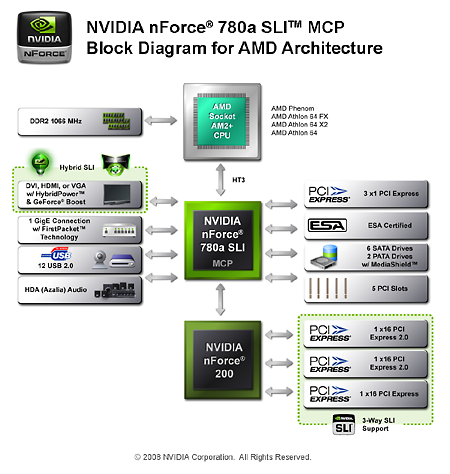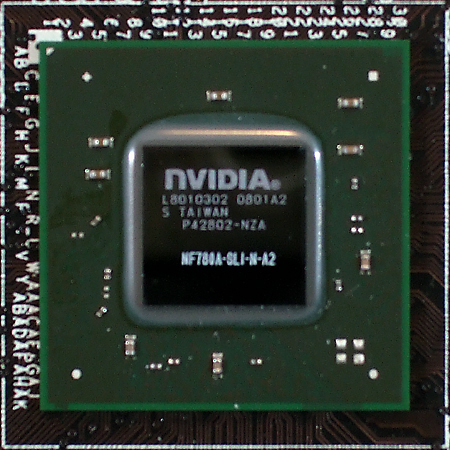NFORCE 780a SLI Motherboard Comparison
A Scooter with a Rocket Engine?
Last week nVidia shocked the enthusiast market by releasing a top-model chipset with integrated graphics. NVidia knew that no self-respecting enthusiast would actually rely on integrated 3D engines, but that wasn’t the point of its 780a SLI. Instead, the announced primary intent was to provide the entire graphics system a way to drop into low power mode when few 3D calculations were required, such as while surfing the internet.

What sets the 780a SLI apart from the lower-budget GeForce 8000 series chipsets isn’t the 780a SLI MCP, but instead the nForce 200 PCI-Express bridge. This bridge provides PCI-Express 2.0 mode to two full-bandwidth x16 slots, or three x16 slots with two in x8 mode. This is the same component that nVidia used to transform its 680i Intel chipset into the 780i, and we’re almost certain that the 780a SLI MCP uses the same 8000 series core as nVidia’s lower-budget parts.

Yes, the nForce 780a SLI still supports GeForce Boost, which is the major feature of the 8000 series to allow low-cost motherboards and graphics cards to be combined into middle-market performers. We tested that feature last week, and found that it worked well for an 8400GS and adequately for an 8500GT. But we didn’t test Hybrid Power because the motherboard we used died before we got that far.
Our experience with the nForce 780i SLI has shown that the nForce 200 bridge is an adequate part for 2-way and 3-way SLI performance, but other tests have proven that AMD’s current processors simply don’t have the performance needed to properly stress such an extensive graphics system.
We could however compare the 780a SLI to the top competing part, AMD’s 790FX. Will the new nForce-equipped motherboards come out on top?
Get Tom's Hardware's best news and in-depth reviews, straight to your inbox.
Current page: A Scooter with a Rocket Engine?
Next Page ASRock K10N780SLIX3-WiFi-
a 6pack in so after reading all this.. i think im stickin with my 790FX. i was waiting for a quite a while for nvidia to pull something here with the 780a chipset. In my eyes its a fail.Reply
AMD's 790FX chipset provides significantly more lanes than nvidia. 3-way SLI is a novel idea but at x8 lanes for 3 slots.. not so much. while amd is providing full x16 support.
good info tho. if anything i would recommend the ASRock board also for nvidia's SLI path. -
johnbilicki I wan to see boards with two 16x slots and one 4x slot. Honestly I'm not interested in 100+ FPS at 1024x768 or 1280x1024 which is what you'll get in most games with triple SLI. The MSI board looks like they could have fit a couple more USB ports next to the useless firewire port. It's 2008 and I have yet to even see a product require a firewire port on products I'm only browsing on sales sites like Newegg or even just review sites. I liked Gigabyte's new quad gigabit port motherboard, finally 8 USB ports on the back! Also if no one shows up with a router at your LAN party three of your buddies can merely connect to your system any way (and who doesn't have dual LAN ports these days besides your cheap who cheaps out by five bucks on a north bridge).Reply
What is with the waste of brackets? Give us four USB ports on a bracket. If you upgrade even only once every four or five years you probably still have about five or six brackets laying around somewhere with all the firewire ports you could ever want...and if not your buddies do.
The dual-slot coolers on single slot cards, what a waste! If you're going to use a second slot don't waste the opportunity to move that hot air the heck out of the case!
My last criticism is the i-ram...DDR-1?! I love Gigabyte when it actually bothers to make boards using chipsets I'd want (they skipped the true 16X SLI and jumped on the then useless AM2 bandwagon however). So why aren't we seeing DDR2 RAM-drives? 4x4GB/32GB would be far out of most people's budgets but a 4x2GB/16GB RAM drive at $40/$160 dimm/total would *own* a raptor raid 0 any day in price/performance.
The manufacturers need to seriously start bringing some people in to the design rooms to question WTF they're thinking with their product designs because I see no reason to bother spending any money right now.
...and to clarify I enjoyed the article itself, it's just the products I hold disappointment in. The new chipset is great overall though. -
nukemaster DDR is still faster then any hard drive interface anyway(DDR 266 @ 2128MB/s), so why not? its actually limited by its sata 150 interface not the ram(it would also max sata 300).Reply
I agree DDR2 is the way to go, but only because the price is much lower and better capacities. When gigabyte designed the I-ram ddr was cheaper and ddr2 was new and expensive.
I think there is a DDR2 I-ram in the making -
I own an evga 780i and I am plagued with the video corruption problem like many other nvidia 7 series owners. BEWARE before you invest on these boards. Nvidia hasn't released a fix in 3 months. Many people can't watch video or play games without encountering a hard lock-up.Reply
Video of problem: http: //www. youtube. com/watch?v=TYHuzJSpORw
http: //www.evga. com/forums/tm.asp?m=253891&mpage=1&key=
http: //nvidia.custhelp. com/cgi-bin/nvidia.cfg/php/enduser/std_adp.php?p_faqid=2190
http: //vip.asus. com/forum/view.aspx?id=20080407161030625&board_id=1&model=Striker+II+Formula&page=1&SLanguage=en-us
http: //forums.anandtech.com/messageview.aspx?catid=31&threadid=2178960&FTVAR_STKEYWORDFRM=&STARTPAGE=1&FTVAR_FORUMVIEWTMP=Linear
http: //digg. com/hardware/780i_nvidia_motherboard_graphics_corruption -
jabliese No comparison of just the integrated graphics? One of the selling points for the 790 is it's DX10 support, would like to see some kind of comparison between just the integrated graphics, say, maybe on HDTV playback.Reply -
unifiedonboarddecoder They should also do the test using an ATi video card. I would like to see those benchmarks as well.Reply
